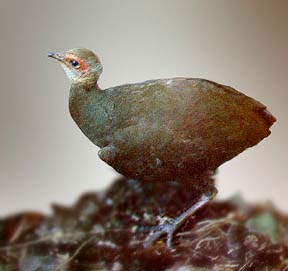|
Kingdom: Animalia Phylum: Chordata Class:
Aves (Birds) Order: Galliformes Family: Megapodiidae Size: 43 cm
|
Status: Endangered. Nicobar
Scrubfowl is endemic to India
 Nicobar Scrubfowl
(Megapodius nicobariensis), also called Nicobar Megapode, is endemic to the
Nicobar group of Indian islands. There is a small possibility that this bird may also be found in Andaman Islands
(India), Cocos Islands (Myanmar) and the nearby islands of Indonesia. Two
geographical subspecies are known; the nominate race Megapodius nicobariensis nicobariensis, found north of the
Sombrero channel, and the southern Megapodius nicobariensis abbotti, on
Great Nicobar and Little Nicobar islands. The later race is slightly smaller and darker.
Nicobar Scrubfowl
(Megapodius nicobariensis), also called Nicobar Megapode, is endemic to the
Nicobar group of Indian islands. There is a small possibility that this bird may also be found in Andaman Islands
(India), Cocos Islands (Myanmar) and the nearby islands of Indonesia. Two
geographical subspecies are known; the nominate race Megapodius nicobariensis nicobariensis, found north of the
Sombrero channel, and the southern Megapodius nicobariensis abbotti, on
Great Nicobar and Little Nicobar islands. The later race is slightly smaller and darker.
Nicobar Scrubfowl, locally called Kongah, is a brownish stout pheasant-like bird with
large powerful legs and toes. Sexes alike, ashy-grey head with bare red
skin showing near the eyes. The underparts are brownish-grey. Immature birds are without the bare red skin patch. Found in pairs or mixed droves
of adults and young near dense undergrowth of evergreen forests on sandy beaches of islands. These
bird are strong runners and spend most of their time on the ground. They
fly only when absolutely necessary and sometimes take shelter on nearby trees.
Their food consists of vegetable matter, seeds, snails and insects.
The Megapode family, or Megapodes, to which Nicobar Scrubfowl belongs, are known as mound-builders
or incubator birds. They do not incubate their eggs with body heat, but bury them
by building large nest-mounds of sand and humus. The eggs incubate by the heat
of decaying vegetation. Chicks use their
claws to break out of the egg, and then tunnel their way up to the surface of
the mound. They hatch feathered, active and ready to lead an independent
existence. There is no parental care; the chicks simply wander away and fend for
themselves. Nicobar Islands being close to the equator, it is assumed that the
Nicobar Scrubfowl breeds all year round.
This species has a small and declining population resulting from loss of habitat with destruction
of the coastal forest. Earlier estimates of its total population were around 5000 to 7000 adult
birds, but after the devastating tsunami of 2004, not more than 2000 may have survived.
It is believed that the tsunami may have washed away their nest-mounds hence
causing a loss of one breeding season. There is
no data available from the interior of islands, where densities are believed to be much lower than
in coastal forests.
Nicobar Scrubfowl is one of three threatened, endemic bird species restricted to the Nicobar Islands,
the other two being the Nicobar Scops-Owl and
Nicobar Sparrowhawk. The main threats are hunting,
egg collection and loss of habitat. Regarding conservation efforts, three uninhabited Nicobar Islands, Batti Malv, Tillanchong and Megapode Island are protected while the Great Nicobar island has two
national parks (Campbell Bay and Galathea).
 Nicobar Scrubfowl
(Megapodius nicobariensis), also called Nicobar Megapode, is endemic to the
Nicobar group of Indian islands. There is a small possibility that this bird may also be found in Andaman Islands
(India), Cocos Islands (Myanmar) and the nearby islands of Indonesia. Two
geographical subspecies are known; the nominate race Megapodius nicobariensis nicobariensis, found north of the
Sombrero channel, and the southern Megapodius nicobariensis abbotti, on
Great Nicobar and Little Nicobar islands. The later race is slightly smaller and darker.
Nicobar Scrubfowl
(Megapodius nicobariensis), also called Nicobar Megapode, is endemic to the
Nicobar group of Indian islands. There is a small possibility that this bird may also be found in Andaman Islands
(India), Cocos Islands (Myanmar) and the nearby islands of Indonesia. Two
geographical subspecies are known; the nominate race Megapodius nicobariensis nicobariensis, found north of the
Sombrero channel, and the southern Megapodius nicobariensis abbotti, on
Great Nicobar and Little Nicobar islands. The later race is slightly smaller and darker.







